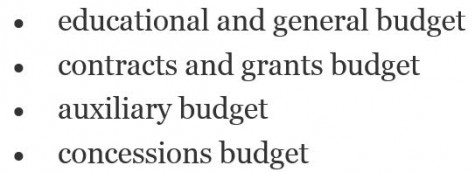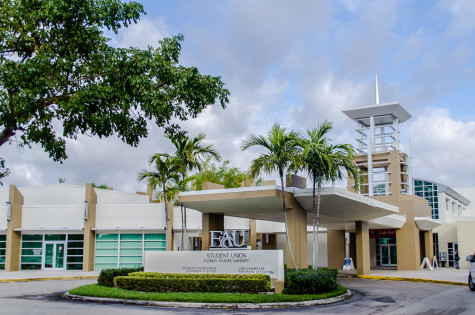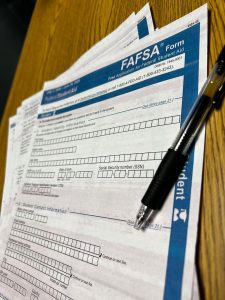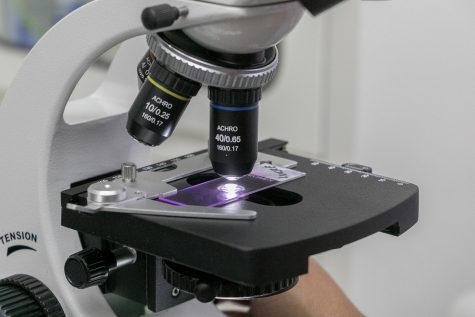FAU’s 2015-16 Operating Budget is approved
Find out where your money is going for the 2015-2016 budget.
President John Kelly at his first state of the university address in the Barry Kaye Auditorium at FAU on Sept. 11, 2014. Photo by Max Jackson
June 29, 2015
Correction: In a previous version of this story, it was reported that the Student Government budget was comprised solely of funding from income raised through activities and services. Although some of the budget is made up from revenues, the majority is funded through an activity and service fee that each student pays as part of their tuition.
Correction: In a previous version of this story, it was reported that the total amount of the operations budget was $11.3 million. However, the $11.3 million is FAU’s share of the $150 million provided from state funding. The total proposed operating budget for 2015-2016 is approximately $727 million.
Florida Atlantic University’s 2015-16 operating budget, approximately $726 million, has been approved by the Board of Trustees.
Due to a number of factors including graduation rates, cost per degree, and job placement, FAU’s share of the $150 million state funding budget “will amount to about $11.3 million in one-time funding for FAU,” according to President John Kelly. This comes after a loss of $7 million dollars the previous year.
The operating budget is prepared annually by the University President and reviewed by departmental units, the president’s executive leadership team and the Board of Trustees’ Committees.
The budget contains estimates of the total value of resources that FAU will need this fiscal year in order to fund all of their academic and athletic programs and activities.
It consists of seven different components–education and general contracts and grants, local athletics, concessions, student financial aid, auxiliary enterprises and Student Government.
There was an increase in the proposed allocations for the following:
 However, the following proposed budgets will receive less funding than the previous year:
However, the following proposed budgets will receive less funding than the previous year:

Look at the full breakdown of the budgets below.
The proposed educational and general, or E&G, budget would facilitate FAU’s academics by providing funds for “instruction, research, library and learning sources, university support and physical plant,” according to the plan. The proposed E&G revenue budget, which includes the College of Medicine, totals to $307,630,566. The proposed E&G expenditure budget was at a base of $275,639,378 and maximum target of $294,831,067.

The student financial aid budget is made up of financial aid fees charged to students, federal and state financial aid awards, programs and private scholarships. The budget totals $196,558,935 in projected expenditures, a 2.8 percent decrease over the previous year.
The contracts and grants budget is comprised of funding from federal, state and local governmental agencies, private organizations, the FAU and Harbour Branch Oceanographic Institute Foundation endowment distribution and A.D. Henderson University School. The budget totals $59,098,850 in projected expenditures, an increase of 6.5 percent due to anticipated increase in research activities.

The auxiliary enterprises budget consist of operations that deal with business and are supported through the use of charging for food, traffic and parking, and HBOI auxiliary operations according to the budget plan . Also included in this budget are the expenditures and revenues of the new technology fee. The Budget totals $139,559,277 in projected expenditures, an increase of 11.3 percent over the prior year due to increases in the medical school GME program, College of Business market rate programs, technology fee and Student Health Services.
The funding for the athletics budget comes from the athletic fees of students, ticket sales, payout games, corporate backing, the National Collegiate Athletic Association distributions and gifts received through private donors. The budget totals $26,346,429 in projected expenditures, a decrease of 3.9 percent over the prior year due to a reduction of game guarantees received.

The Student Government budget is primarily composed of funding from the activity and service fee that students pay as part of their tuition. Some additional funding for this budget is made up from revenue that students make through these programs. The Student Government budget totals $9,876,445 in projected expenditures, a decrease of 12.0 percent over the prior year according to the budget plan.
The concessions budget is derived from the revenue made from the purchase of soft drinks and snack vending machines. The budget totals $625,000 in projected expenditures due to the new negotiated contract from Coca-Cola.
Kelly states that “overall, FAU had a productive year in the legislature and we will put all funding received to strategic use.”
















